“ Ifugao: Where Custom Is The
Basis Of All Laws “
“A Laidback Philippine Province Of
Natural Lures And Wonders”
Ifugao is a laidback, mountainous province in the Cordillera Region of Northern Luzon, Philippines. Its many natural lures can meet your simple-to-elegant desires for a place to see, live or invest in.
Its people have remained steadfast to their mores that custom is the basis of all laws, even as modernity slowly creeps on them.
The sceneries of the province are stunning. You will cherish the grandeur of its 5 clusters of rice terraces… its centerpiece attraction.
You will wonder how its people built those terraces with primitive tools 2,000 years ago.
Ifugao Tribe
The known tribes of the province are Tuwali, Ayangan, Hanglulo and Kalanguya. They are distinguished by their dialects.
Here are some tribe elders beaming proudly for tourists…
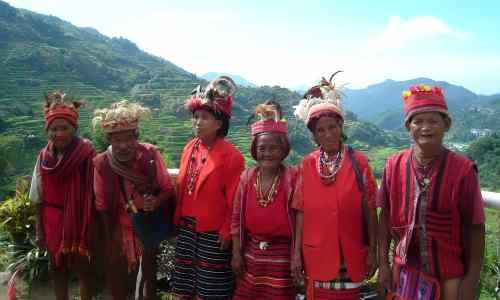
Here's their typical tribal houses…
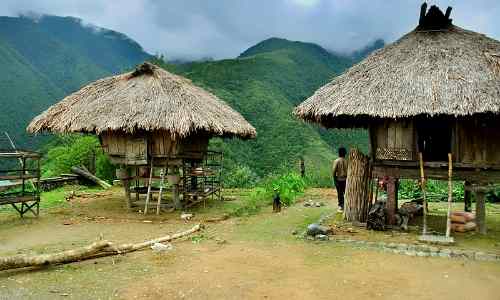
Here's a display of their clothing resembling the native garbs of Bukidnon and Davao del Norte…
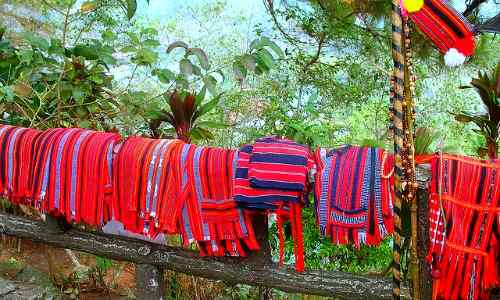 Source: flickr.com | Google images
Source: flickr.com | Google images
Ifugao History
They were once feared head-hunters, like the other tribes in Benguet and Kalinga. They were once very antagonistic to strangers… always suspecting of them as dominion grabbers.
Their anthropological ancestry is unclear. Some scholars say they descended from Malayan immigrants. Some say they may have come from the Miao tribe of China.
This Miao line is interesting. The Miaos were rice growing experts who inhabited the wet mountain regions of Southern China… where today rice terraces exist, but not as steep as the Philippines’.
The Miaos fought Yu The Great of the Han-Chinese empire circa 2200 BC and almost got obliterated. To escape further carnage, they migrated into Indo-China.
Some of them may have gone farther to the Philippines… eventually founding a vast mountain redoubt in the Cordilleras. For some strange coincidence…
The rituals and traditions of the Ifugaos resemble to Miao culture. Many of them are chinky-eyed. I have seen some of them in Pangasinan and Bulacan. You would wander if they have Chinese blood… only they’re darker. Then…
The Spaniards and Japanese failed against them. The Japanese fought last in the province. The vestiges are there now… a war memorial and the surrender site of General Yamashita.
Here's the War Memorial at Kiangan…
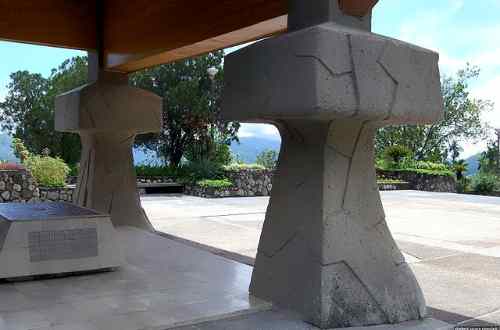
Here's the Yamashita Surrender Site at Kiangan...
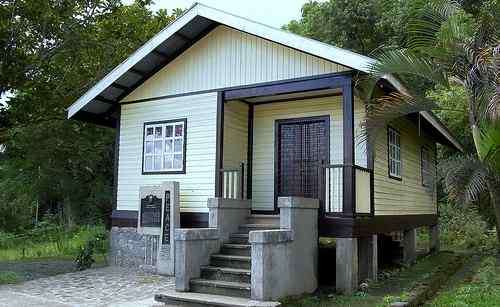 Source: Google images
Source: Google images
Their Culture
The tribe speaks various tribal dialects, such as Tuwali and Ayangan. They also speak Ilokano and Tagalog. Many are fluent in English.
Their culture and society center on rice as basis for subsistence, power and medium of exchange… a kind of prestige crop. Various feasts are held linking rice cultural management and the deities they infer.
While they mourn during funerals, they are also celebrating, believing better life for the departed after death. Six years after burial, the bones are dug up… and a second celebration is held… and a third after another six years.
Ifugao Dance
The tribe has a war dance (bangibang) traced to periods of past tribal conflicts. It is traditionally held on the stone walls of the rice terraces by men brandishing spears, axes and wooden shields. These men prominently wear headdresses made of leaves.
There’s another dance… the Uyaoy. It’s a wedding dance accompanied by gongs and performed by the affluent to attain the second tier of the wealthy’s caste system.
The wealthy (kadangyan) who dance it are entitled to the use of gongs at their death.
The wealthy's Uyaoy dance…
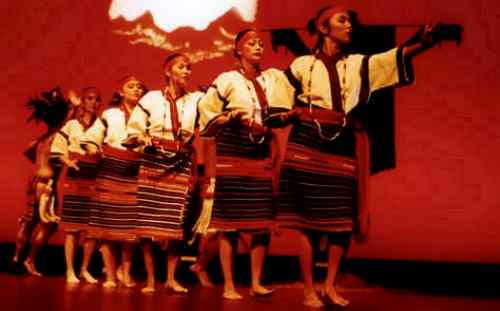 Source: Google images
Source: Google images
Ifugao MapHere’s the map of the province…
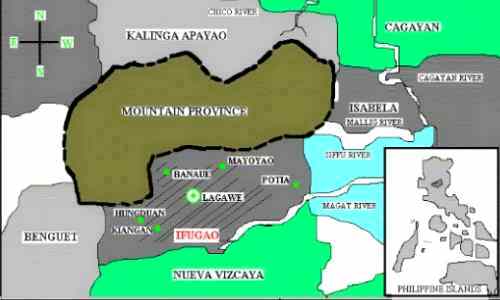 Source: Google images
Source: Google images
Ifugao Rice TerracesThe rice terraces (called payoh) are built from the base of the mountain upwards. They are lined with sturdy stone walls averaging 3-5 meters tall… a few reach 50 feet.
Terracing is done on steep slopes because it’s the most acceptable solution. Carefully selected sites require water source in higher grounds.
The source is a forest watershed called muyong. It is privately owned through inheritance. Usually, the youngest daughter is the inheritress.
Some muyongs are communally owned. One muyong measures 1.5-5 hectares and works well in rainy Cordilleras. It dams rainwater and/or spring water. Then...
Water is distributed to the terraces using bamboo poles. A check valve, though primitive, is provided.
Today, muyongs irrigate 20,000 hectares of paddies on 5 large clusters of terraces…
- Batad, Banaue cluster
- Bangaan, Banaue cluster
- Mayoyao cluster
- Nagacadan, Kiangan cluster
- Hungduan cluster
During December-April, the terraces exude green with young crops. By May-July, they turn yellow as the crops mature.
Here's the rice terraces in Banaue readied for planting…
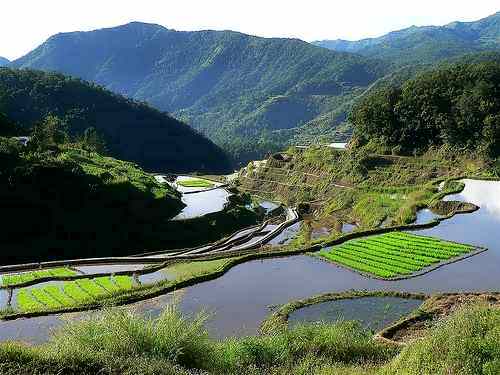 Source: Google images
Source: Google images
Here’s the Banaue rice terraces blooming green with mid-growth rice…
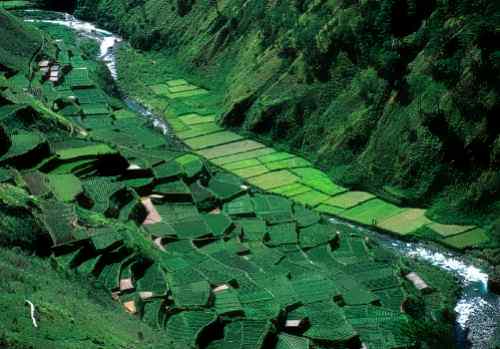
Getting the Batad rice terraces ready for planting…
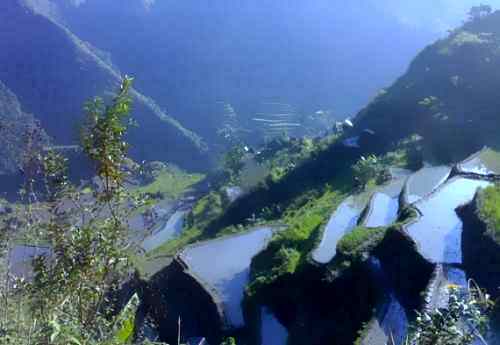
Here’s a closer look of mid-growth Ifugao rice…
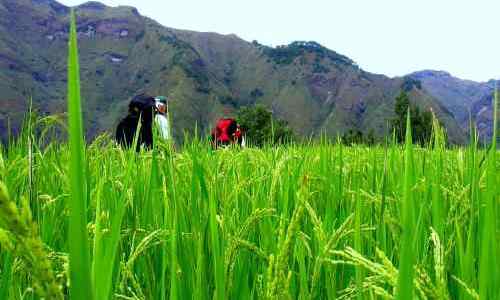 Source: bbossphils.blogspot.com | Google images
Source: bbossphils.blogspot.com | Google images
Here’s the organic Harvested Tinawon Rice which are…
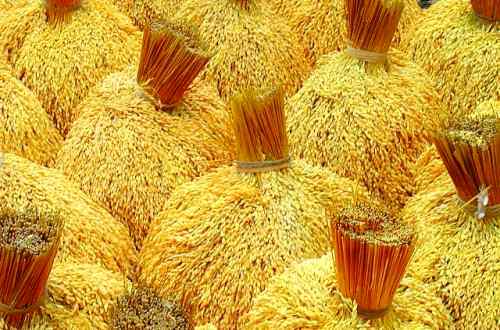
Then milled and stored in these
rice storage baskets…
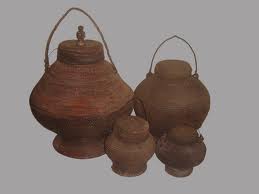
In closing…
Ifugao is laidback and mountainous. It has many natural lures and wonders to meet your simple-to-elegant desires for a place to see, live or invest in.
Its people remain steadfast to their mores… custom is the basis of all laws. Modernity slowly creeps on them though.
Your visit to the Philippines is incomplete without an encounter with the rice terraces and the tribe.
Back to top of this page
Return from Ifugao page to Philippine Provinces page
Return from Ifugao page to Top Destination Choice The Philippines Home Page